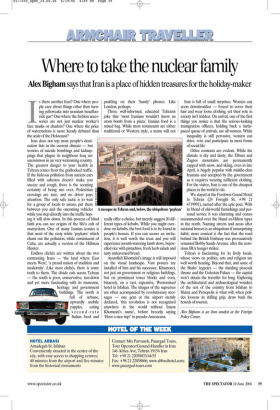Where to take the nuclear family
Alex Bighamsays that Iran is a place of hidden treasures for the holiday-maker
REX FEATURES
Is there another Iran? One where people care about things other than turning yellowcake into uranium hexafluoride gas? One where the fashion accessories are not just nuclear worker’s face masks or chadors? One where the price of watermelons is more keenly debated than the scale of the Holocaust?
Iran does not top most people’s destination lists in the current climate — but worries of suicide bombings and kidnappings that plague its neighbour Iraq are uncommon in an very welcoming country. The greatest danger to your health in Tehran comes from the gridlocked traffic. If the hideous pollution from ancient cars filled with asbestos doesn’t make you sneeze and cough, there is the seeming certainty of being run over. Pedestrian crossings are rare, and no driver pays attention. The only safe tactic is to wait for a group of locals to amass, put them between you and the oncoming vehicles while you step directly into the traffic hoping it will slow down. In this process of blind faith you can see origins of the Shi’a cult of martyrdom. One of many Iranian ironies is that most of the rusty white ‘paykans’ which churn out the pollution, while reminiscent of Cuba, are actually a version of the Hillman Hunter.
Endless clichés are written about the two contrasting Irans — ‘the land where East meets West’, ‘a proud nation of tradition and modernity’. Like most clichés, there is some truth to them. The divide cuts across Tehran — the south is poor, conservative, run-down and yet more fascinating with its museums, heritage and government buildings. The north is full of urbane, upwardly mobile yuppies, eating second-rate Italian food and prattling on their ‘handy’ phones. Like London, perhaps.
Those well-informed, educated Tehranis joke that ‘most Iranians wouldn’t know an atom bomb from a pizza’. Iranian food is a mixed bag. While most restaurants are either traditional or Western style, a menu will not really offer a choice, but merely suggest 20 different types of kebabs. While you might overdose on kebabs, the best food is to be found in people’s houses. If you can secure an invitation, it is well worth the treat and you will experience mouth-watering lamb stews, bejewelled rice with pistachios, fresh herb salads and tasty unleavened bread.
Ayatollah Khomeini’s image is still imposed on the visual landscape. Vast posters are installed of him and his successor, Khamenei, not just on government or religious buildings, but on prominent tower blocks and even, bizarrely, on a vast, expensive, Westernised hotel in Isfahan. The images of the supremes are often accompanied by revolutionary messages — one gem at the airport sternly declared, ‘this revolution is not recognised anywhere in the world without Imam Khomeini’s name’, before breezily saying ‘Have a nice trip!’ in pseudo-Americana. Iran is full of small surprises. Women can seem downtrodden — forced to cover their hair and wear loose clothing, yet their role in society isn’t hidden. On arrival, one of the first things you notice is that the serious-looking immigration officers, holding back a turtlepaced queue of arrivals, are all women. While inequality is still pervasive, women can drive, vote and participate in most forms of social life Other contrasts are evident. While the climate is dry and dusty, the Elburz and Zagros mountains are permanently capped with snow, and skiing, even in late April, is hugely popular with middle-class Iranians and accepted by the government as it requires wearing sufficient clothing. For the visitor, Iran is one of the cheapest places in the world to ski.
We stayed at the Ferdowsi Grand Hotel in Tehran (24 Forughi St, +98 21 6719991), named after the epic poet. With its blend of old-world furnishings and personal service it was charming and comes recommended over the bland ex-Hilton types in the north. Naming streets and areas after national heroes is an ubiquitous if unsurprising habit; more comical is the fact that the road behind the British Embassy was provocatively renamed Bobby Sands Avenue, after the notorious IRA hunger striker.
Tehran is fascinating for its lively locals, whose views on politics, arts and religion are well worth hearing. Beyond that, and some of the Shahs’ legacies — the dazzling peacock throne and the Golestan Palace — the capital won’t detain the traveller for long. Exploring the architectural and archaeological wonders of the rest of the country from Isfahan to Shiraz and Persepolis is what will, when politics loosens its stifling grip, draw back the hoards of tourists.



















































 Previous page
Previous page